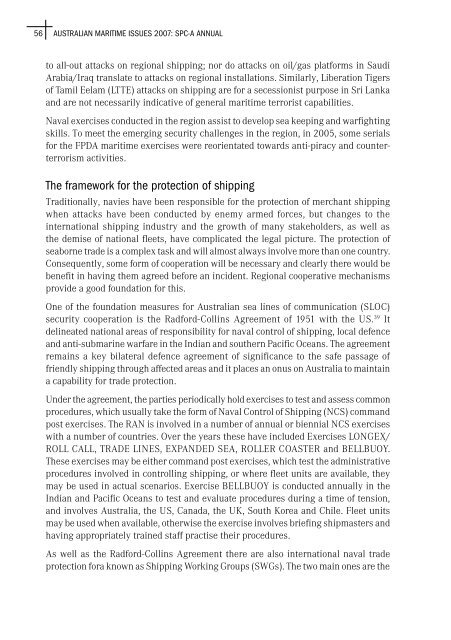Australian Maritime Issues 2007 - Royal Australian Navy
Australian Maritime Issues 2007 - Royal Australian Navy
Australian Maritime Issues 2007 - Royal Australian Navy
You also want an ePaper? Increase the reach of your titles
YUMPU automatically turns print PDFs into web optimized ePapers that Google loves.
56 AUSTRALIAN MARITIME ISSUES <strong>2007</strong>: SPC-A ANNUAL<br />
to all-out attacks on regional shipping; nor do attacks on oil/gas platforms in Saudi<br />
Arabia/Iraq translate to attacks on regional installations. Similarly, Liberation Tigers<br />
of Tamil Eelam (LTTE) attacks on shipping are for a secessionist purpose in Sri Lanka<br />
and are not necessarily indicative of general maritime terrorist capabilities.<br />
Naval exercises conducted in the region assist to develop sea keeping and warfighting<br />
skills. To meet the emerging security challenges in the region, in 2005, some serials<br />
for the FPDA maritime exercises were reorientated towards anti-piracy and counterterrorism<br />
activities.<br />
The framework for the protection of shipping<br />
Traditionally, navies have been responsible for the protection of merchant shipping<br />
when attacks have been conducted by enemy armed forces, but changes to the<br />
international shipping industry and the growth of many stakeholders, as well as<br />
the demise of national fleets, have complicated the legal picture. The protection of<br />
seaborne trade is a complex task and will almost always involve more than one country.<br />
Consequently, some form of cooperation will be necessary and clearly there would be<br />
benefit in having them agreed before an incident. Regional cooperative mechanisms<br />
provide a good foundation for this.<br />
One of the foundation measures for <strong>Australian</strong> sea lines of communication (SLOC)<br />
security cooperation is the Radford-Collins Agreement of 1951 with the US. 39 It<br />
delineated national areas of responsibility for naval control of shipping, local defence<br />
and anti-submarine warfare in the Indian and southern Pacific Oceans. The agreement<br />
remains a key bilateral defence agreement of significance to the safe passage of<br />
friendly shipping through affected areas and it places an onus on Australia to maintain<br />
a capability for trade protection.<br />
Under the agreement, the parties periodically hold exercises to test and assess common<br />
procedures, which usually take the form of Naval Control of Shipping (NCS) command<br />
post exercises. The RAN is involved in a number of annual or biennial NCS exercises<br />
with a number of countries. Over the years these have included Exercises LONGEX/<br />
ROLL CALL, TRADE LINES, EXPANDED SEA, ROLLER COASTER and BELLBUOY.<br />
These exercises may be either command post exercises, which test the administrative<br />
procedures involved in controlling shipping, or where fleet units are available, they<br />
may be used in actual scenarios. Exercise BELLBUOY is conducted annually in the<br />
Indian and Pacific Oceans to test and evaluate procedures during a time of tension,<br />
and involves Australia, the US, Canada, the UK, South Korea and Chile. Fleet units<br />
may be used when available, otherwise the exercise involves briefing shipmasters and<br />
having appropriately trained staff practise their procedures.<br />
As well as the Radford-Collins Agreement there are also international naval trade<br />
protection fora known as Shipping Working Groups (SWGs). The two main ones are the
















